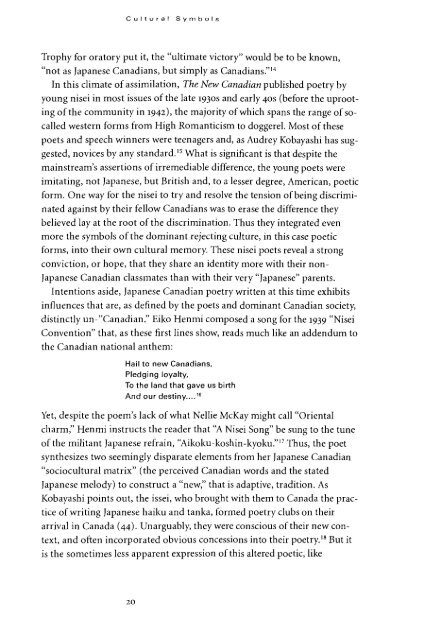To All Appearances A Lady - University of British Columbia
To All Appearances A Lady - University of British Columbia
To All Appearances A Lady - University of British Columbia
Create successful ePaper yourself
Turn your PDF publications into a flip-book with our unique Google optimized e-Paper software.
Cultural<br />
Symbols<br />
Trophy for oratory put it, the "ultimate victory" would be to be known,<br />
"not as Japanese Canadians, but simply as Canadians." 14<br />
In this climate <strong>of</strong> assimilation, The New Canadian published poetry by<br />
young nisei in most issues <strong>of</strong> the late 1930s and early 40s (before the uprooting<br />
<strong>of</strong> the community in 1942), the majority <strong>of</strong> which spans the range <strong>of</strong> socalled<br />
western forms from High Romanticism to doggerel. Most <strong>of</strong> these<br />
poets and speech winners were teenagers and, as Audrey Kobayashi has suggested,<br />
novices by any standard. 15 What is significant is that despite the<br />
mainstream's assertions <strong>of</strong> irremediable difference, the young poets were<br />
imitating, not Japanese, but <strong>British</strong> and, to a lesser degree, American, poetic<br />
form. One way for the nisei to try and resolve the tension <strong>of</strong> being discriminated<br />
against by their fellow Canadians was to erase the difference they<br />
believed lay at the root <strong>of</strong> the discrimination. Thus they integrated even<br />
more the symbols <strong>of</strong> the dominant rejecting culture, in this case poetic<br />
forms, into their own cultural memory. These nisei poets reveal a strong<br />
conviction, or hope, that they share an identity more with their non-<br />
Japanese Canadian classmates than with their very "Japanese" parents.<br />
Intentions aside, Japanese Canadian poetry written at this time exhibits<br />
influences that are, as denned by the poets and dominant Canadian society,<br />
distinctly un-"Canadian." Eiko Henmi composed a song for the 1939 "Nisei<br />
Convention" that, as these first lines show, reads much like an addendum to<br />
the Canadian national anthem:<br />
Hail to new Canadians,<br />
Pledging loyalty,<br />
<strong>To</strong> the land that gave us birth<br />
And our destiny.... 16<br />
Yet, despite the poem's lack <strong>of</strong> what Nellie McKay might call "Oriental<br />
charm," Henmi instructs the reader that "A Nisei Song" be sung to the tune<br />
<strong>of</strong> the militant Japanese refrain, "Aikoku-koshin-kyoku." 17 Thus, the poet<br />
synthesizes two seemingly disparate elements from her Japanese Canadian<br />
"sociocultural matrix" (the perceived Canadian words and the stated<br />
Japanese melody) to construct a "new," that is adaptive, tradition. As<br />
Kobayashi points out, the issei, who brought with them to Canada the practice<br />
<strong>of</strong> writing Japanese haiku and tanka, formed poetry clubs on their<br />
arrival in Canada (44). Unarguably, they were conscious <strong>of</strong> their new context,<br />
and <strong>of</strong>ten incorporated obvious concessions into their poetry. 18 But it<br />
is the sometimes less apparent expression <strong>of</strong> this altered poetic, like<br />
20

















